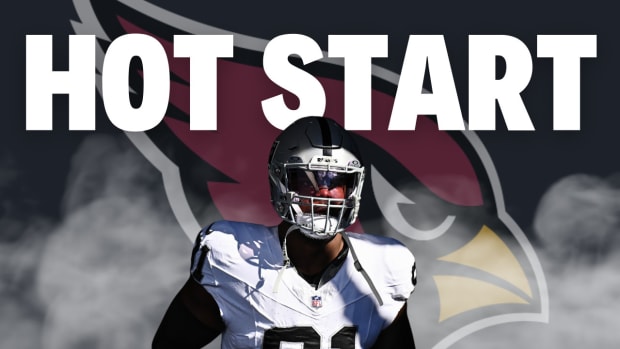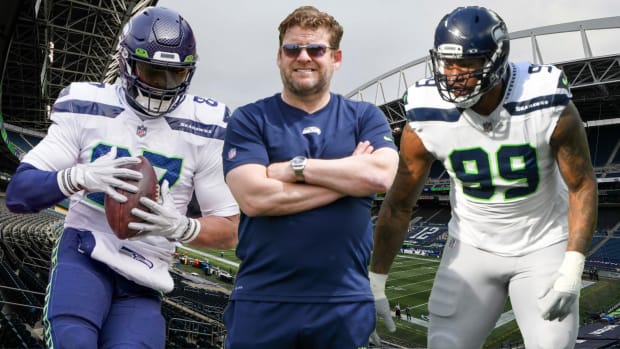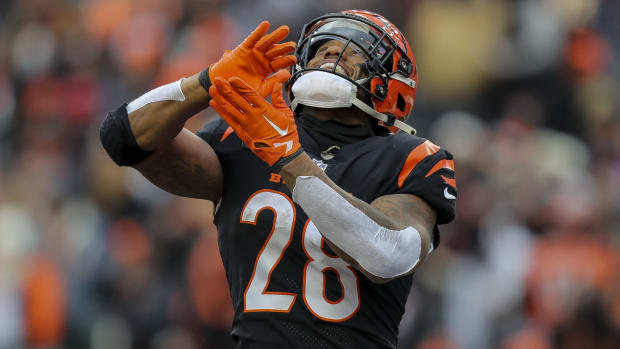
The Grand Experiment
FAIR LAWN, N.J. — The clock reads 3:25 p.m. Time for T.J. Clemmings’ third workout of the day.
He’s been here at Parisi Speed School, located in a New Jersey suburb just across the George Washington Bridge from New York City, for five hours already. His first two workouts were pretty standard for a combine-bound player. He ran splits of the 40-yard dash, and he practiced the 225-pound bench press.
Now it’s time to get back to work on the experiment, one that’s been in the works for a little more than two years. Can a basketball player-turned-defensive end now become one of the most important players on the offensive side of the ball: an NFL left tackle?
For the next 45 minutes, the corner of an indoor turf field becomes a laboratory. Clemmings parses the movements of an offensive lineman down to the tiniest minutiae. The width of his steps. The height of his hips. The angle of his back. The orientation of his hands. A local high school football team comes in for an after-school workout, and a few wide-eyed kids stare as the 307-pound Clemmings grunts and lunges while lassoed with a harness of resistance bands.
“Looks like the rodeo,” one boy whispers to a friend.
First up is an anti-bull rush drill. Clemmings played right tackle at Pitt, but he starts in a left-sided stance, his left foot staggered behind his right heel. He grips two black handles that are connected to purple resistance bands, held taut by a coach standing behind him. On the sound of a snap count—“Blue 19, Blue 19!” —Clemmings kick slides twice, back and to the left, and stabs both arms forward.
The force of an imaginary rusher is simulated by the coach yanking those resistance bands backwards, but something doesn’t go quite right. Clemmings curled his back and stuck his chest out, a position that leaves him vulnerable to being pushed over. His form breaks. He’s supposed to be an anchor—that’s the job definition of a tackle—so he needs to have his shoulders down, a tight core and low hips. He tries again, at 50 percent speed. Then, at full speed. Then, again, trying to keep his arms extended out for a full five seconds. Beads of sweat pour off his brow.
“Don’t let the bands defeat you,” Clemmings says. What he’s really saying is, Don’t let the pass rusher defeat you. Clemmings used to be that pass rusher. Now, his rare physical gifts are being put to work as a pass protector, one that is ticketed for the first round of the NFL Draft.
* * *
Draft Projections
Mariota to the Jets? Shaq Thompson to South Beach? A new receiving star for Flacco? A new Wilfork in New England? NFL film study maven Andy Benoit identifies teams' biggest needs, and Andy Staples provides the prospects who fit the bill. DRAFT PROJECTIONS HUB
If you ask an NFL talent evaluator about Clemmings, they most likely start with the r-word: “raw.” That’s usually associated with another word that’s even more ubiquitous this time of year: “upside.” But what do those words really mean?
In Clemmings’ case, it means that he has all the physical tools to be an NFL tackle—6-foot-5 frame, long arms and natural athleticism—but he’s still mastering the technique that makes or breaks the position. This time of year is often the silly season, featuring the so-called underwear Olympics this week in Indianapolis, where prospects are herded through tests that may have very little to do with their NFL futures. But for Clemmings, who is training six days a week at Parisi, it’s a unique window of time to play catch-up on years worth of lessons in fundamentals.
Not only had he never played offense until a bowl-game practice at the end of his redshirt sophomore year, he had never played organized football of any kind until his junior year of high school. Clemmings grew up just 10 minutes from where he’s training, in Teaneck, N.J., the only son among Fay and Trevor Sr.’s four kids. Fay, who works as a home health aide, worried her son would get hurt playing football.
“He thought he was a basketball player,” says Benjie Wimberly, who coached Clemmings at Paterson Catholic High. “Until I harassed him enough that he decided to come out for football his junior year.”
Paterson Catholic, perhaps known best as Victor Cruz’s alma mater, shut its doors in 2010, but its football program had been a juggernaut, winning six state titles in the decade before it closed. That didn’t matter much to Clemmings, whose first love was basketball. But when Wimberly saw the teen physically overpowering opponents on the hardwood, he knew he had to have him on his football team.
As a 16-year-old kid, Clemmings finally got his mother’s blessing to get on the gridiron. He knew next to nothing about the sport. Wimberly’s first lesson for his newest player: How to put on a football uniform.
Wimberly figured his best bet was to use Clemmings as a pass rusher. His two instructions: 1) Keep your outside shoulder free, and 2) attack the ball. (Those turned out to be easier lessons than how to put on pads). Most of the Paterson Catholic team played one-way. As Wimberly recalls, Clemmings’ only exposure to blocking was a handful of practice reps as a jumbo tackle or tight end.
Clemmings’ athleticism jumped off the film for college coaches, even if they weren’t even looking for him. He had scholarship offers to play basketball at Big East schools Seton Hall and Providence, but by his senior year, one recruiting service had ranked him as the top overall football recruit in the state of New Jersey. Then-Rutgers coach Greg Schiano visited Paterson Catholic via helicopter, landing on the football field and meeting with Clemmings in the football office. Notre Dame and Penn State were also among the schools that made offers. Clemmings chose Pitt.
* * *
Photo by Keith Srakocic/AP
Playing offense? By the time he arrived at Pitt, Clemmings would have laughed at that idea. In fact, it was a joke: As he struggled to handle the steep learning curve of the college game, teammates would tease him that he should play on the offensive line. He’d get annoyed.
He lettered as a true freshman, but that December coach Dave Wannstedt, who had recruited Clemmings, resigned. His replacement, Todd Graham, had Clemmings redshirt as a sophomore. Graham left to take the Arizona State job after one season, making Paul Chryst Clemmings’ third coach as he headed into his third season at Pitt. Any development stalled. By the end of that season, he wasn’t getting onto the field at all. His career was at a crossroads.
Walking off the field after the regular-season finale against South Florida, Chryst noticed Clemmings’ jersey was clean. As he looked at 6 feet, 5 inches of untapped potential, inspiration struck.
Hey T.J., what do you think about playing offensive line?
This time, Clemmings didn’t laugh. He asked Chryst if he could think about it. The next day, he said yes. And with that, the experiment was underway.
The LB Who Couldn't Hit
Washington’s Shaq Thompson spent the past three seasons proving he’s capable of just about anything on the football field; he’s a likely first-round pick in this year’s draft. But the first time he went pro, as a centerfielder, he proved to be anything but a can’t-miss prospect, Emily Kaplan writes. FULL STORY
It would be nine months before Clemmings played his first live game snap on the offensive line. But the first time he executed a block, in a bowl-game practice a couple days after his conversation with Chryst, he felt something that had been missing on defense.
“It was the feeling of, ‘Oh man, I just moved somebody from where they wanted to be,’ ” Clemmings says.
Most people assume Clemmings brought his nasty demeanor over from the defensive side of the ball. That wasn’t the case.
“That tenacity, this physical aura of me just came when I put my hand down as an offensive lineman,” he says. “It is still hard for me to talk about how that happened. Something just happened naturally. Ever since then, I have played the position with a mean streak I didn’t have on defense.”
The position switch was the catalyst. “It was energizing,” Chryst says. But the synthesis of Clemmings’ physical tools into an NFL-ready offensive lineman is far from complete.
* * *
Clemmings had a visitor at one of his workouts last month. Kareem McKenzie, who spent 11 seasons playing offensive tackle in the NFL, is a full-time master’s student in professional counseling at nearby William Paterson University. On a free afternoon, he came by the Parisi facility to spend a couple hours with Clemmings.
“How many pass sets do you have?” McKenzie asked.
“Two?” Clemmings answered tentatively. “Are there more? How many sets do you have?”
“Five,” McKenzie said.
Pass sets are the way a lineman steps and leverages his body on pass plays, to carve out a pocket for his quarterback and protect him from rushers. Clemmings had used a jump set, which mimics a run block, and a vertical set, in which you retreat from the line before taking an anchor step. McKenzie showed him a wide pass set, where he would push a defender wide, and different step combinations, like 2x3 (two kick steps wide and three kicks back) or 4x5 (four kick steps wide and five kicks back).
“It’s not checkers, it is chess,” McKenzie says. “You are trying to do something to set up the next play, or a couple plays down the line. Give them a different look, rather than doing the same thing over and over again.”
McKenzie’s analogy is one he borrowed from Hall of Fame tackle Jackie Slater: with every new technique an offensive lineman masters, he adds to his toolbox. When teams use the word “upside,” that means that Clemmings has the potential to load up that toolbox over time.
Tale of a Combine Snub
California wide receiver Chris Harper declared early for the draft but was among a number of underclassmen not invited to the combine. What happens now? Plus, get to know an ex-Oregon QB not named Marcus Mariota. FULL STORY
So far, Clemmings has had the right mentors. Chryst, now Wisconsin’s head coach, had four future first-round picks on the offensive line during his previous stint as the Badgers’ offensive coordinator: Joe Thomas (2007), Gabe Carimi (2011), Kevin Zeitler (2012) and Travis Frederick (2013). Jim Hueber, Chryst’s offensive line coach at Pitt, also spent five years coaching o-line in the NFL.
Clemmings might as well have been starting from zero, just like the 16-year-old back at Paterson Catholic. He not only had to learn college-level pass protections and run techniques, but simple terminology, like the words that indicate a play will be run to the right or to the left. Pitt was rebuilding again, and the Panthers didn’t have the luxury of time to ease Clemmings into a starting role. He was thrown into the fire for better or—more often—for worse, as the 2013 season-opener against Florida State approached.
But there were enough early positive signs for the coaches to stick with him. As a converted defender, his ability to move his feet and work in space came easily, as did making contact. “There were times, early, when things were frustrating,” Chryst says. “But at the same time, I remember in that first bowl practice, he did some stuff where we were like, ‘That’s… different. O.K., that’s pretty dang good.’ ” His athleticism, for example, allowed him to lead sweep plays and get to linebackers at the second level. Clemmings started all 13 games at right tackle in 2013. His anything-to-win attitude and natural leadership led to teammates voting him the team’s offensive captain heading into his senior season.
In the classroom, Hueber showed a lot of old Wisconsin film, and Clemmings zeroed in on the way Joe Thomas moved. Before becoming an eight-time Pro Bowler in Cleveland, Thomas was an unusually polished college player in Madison. And, like Clemmings, Thomas spent time on the defensive side of the ball, too. “There was an athleticism I wanted T.J. to see,” Hueber says. “An ease of movement.”
Between his junior and senior seasons, Clemmings’ trainer in New Jersey made a suggestion that seemed silly to him at the time. But he obliged. At the start of each workout, he would put his hand in the ground and recite his goals: All-American, All-ACC, first-round draft pick. “Sometimes I wasn’t sure if I really believed that I could actually achieve these goals,” he says. “We kind of spoke it into existence.” Clemmings was voted second-team All-America last fall, and first-team All-ACC. And as for first-round draft pick?
NFL Network analyst Mike Mayock ranks Clemmings as the No. 1 offensive tackle (he lists Iowa’s Brandon Scherff, his top lineman, as a guard) and estimates he’ll be drafted between No. 15 and 25, with a future at left tackle. Clemmings was thrust into the left tackle spot for a large portion of Senior Bowl week, an open audition to be a team’s blindside protector, and struggled. But Mayock, who says Clemmings' talent is obvious, doesn’t think that will hurt his stock. “He went out and competed,” Mayock says, just like he did through the early bumps in the road when this experiment began at Pitt.
One high-ranking AFC personnel executive, though, had a more conservative take. He sees good—when Clemmings has struggled, it’s been due to technique, which is fixable—and some bad. He noticed some hip stiffness, which could impact his lateral quickness. “Wouldn’t consider before the second round, at this point,” the personnel executive cautioned. “The athleticism can be a tease.”
* * *
Photo by Jenny Vrentas/The MMQB
Back on that corner of turf at the Parisi Speed School, Clemmings is now wearing two green resistance bands criss-crossed over his chest. He’s back in a right tackle stance. He wants to be ambidextrous, available to teams on either the right or left side, so he’s practicing both.
This is a run-blocking drill, mimicking an outside draw play. His trainer stands behind him again, yanking on those bands, as Clemmings tries to plow forward for five yards toward an end point marked by a speed cone. On his first attempt, he steps too wide with his right foot, which throws him off balance. He gives into the bands. He tries again, but this time, drags his left foot across his body. He’s supposed to move like a ballroom dancer—stepping lightly, with precision.
The pass-blocking drills Clemmings practiced earlier were similar to one of the most important position-specific drills he’ll perform in front of all 32 teams at the NFL combine, the kick-slide drill. Now he is envisioning himself on a football field, clearing space for his running back, picking up linebackers or defensive backs as he drives downfield. On his third try, he masters the steps and extends his arms as he charges forward. When he gets to five yards, he jerks his hands as if he’s making a hard right turn with the steering wheel—pretending to throw a defender down to the turf, making up for lost years of muscle memory.
“All the way to the ground,” he murmurs as he pops back up.
Chryst doesn’t pretend to have known that the experiment they began at Pitt would take Clemmings this far. The question now, is how much further the road will take him.
“I’m not even close,” Clemmings says. And he means that in a good way.
Follow The MMQB on Facebook, Twitter and Instagram.
[widget widget_name="SI Newsletter Widget”]










































